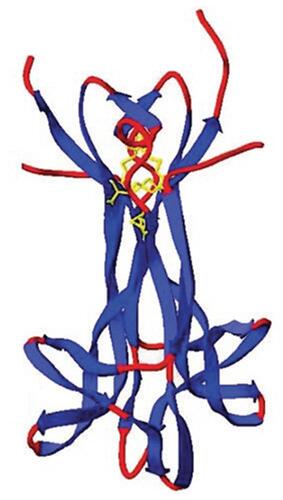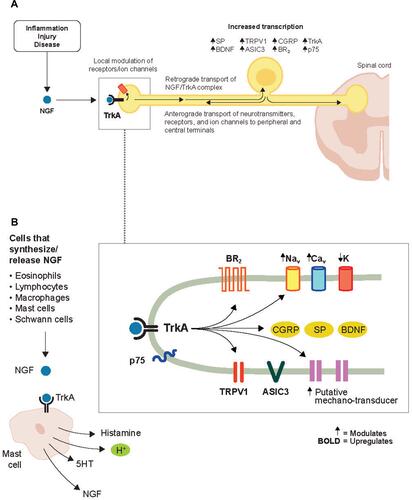Figures & data
Figure 1 X-ray crystallographic structure of human NGF homodimer. NGF is a homodimer consisting of 2 strands of 120 amino acids each, which non-covalently dimerize to form a 26-kDa protein. Note the N-terminus of the monomers is not apparent (unresolved). Copyright© 2006. Portland Press. Reproduced with permission from Allen SJ, Dawbarn D. Clinical relevance of the neurotrophins and their receptors. Clin Sci (Lond). 2006;110(2):175–191.Citation7
Abbreviation: NGF, nerve growth factor.

Table 1 Summary of Disease States or Conditions in Humans in Which Increased Levels of NGF Were Detected Compared with Controls
Figure 2 Nociceptive effects of NGF on inflammatory cells. NGF binds TrkA receptors on inflammatory cells. The resulting NGF/TrkA signaling increases the release of a variety of inflammatory mediators such as serotonin, histamine, and NGF itself, which are known to cause sensitization of nociceptors via modulation of receptor or ion channel activity at the peripheral terminal.
Abbreviations: 5-HT, 5-hydroxytryptamine (serotonin); NGF, nerve growth factor; TrkA, tropomyosin receptor kinase A.

Table 2 Summary of Short- and Intermediate/Long-Term Effects of NGF Signaling on Ion Channels, Receptors, and Peptides
Figure 3 Effects of NGF on nociceptive ion channels, receptors, and peptides. (A) NGF signaling increases the activity of a variety of ion channels and receptors at the nociceptor peripheral terminal, which promotes depolarization and sensitization in a relatively short time frame. In a longer time frame, the NGF/TrkA complex is retrograde transported to the soma where NGF/TrkA signaling within the DRG promotes gene expression and leads to an upregulation of nociceptive ion channels, receptors, and peptides in the peripheral and central terminals. (B) NGF is released from a variety of cells following inflammatory injury. Reproduced with permission from Mantyh PW, Koltzenburg M, Mendell LM, Tive L, Shelton DL. Antagonism of nerve growth factor-TrkA signaling and the relief of pain. Anesthesiology (Official Journal of the American Society of Anesthesiologists). 2011;115(1):189–20Citation6; https://anesthesiology.pubs.asahq.org/article.aspx?articleid=1933906.
Abbreviations: ASIC3, acid-sensing ion channel 3; BDNF, brain-derived neurotrophic factor; BR, bradykinin receptor; Ca, calcium; CGRP, calcitonin gene-related peptide; DRG, dorsal root ganglion; K, potassium; Na, sodium; NGF, nerve growth factor; SP, substance P; TrkA, tropomyosin receptor kinase A; TRPV1, transient receptor potential cation channel subfamily V member 1.

Figure 4 Preventative administration of anti-NGF antibody reduces metastatic prostate cancer-induced CGRP+ and NF200+ sensory nerve sprouting. (A and D) CGRP+ and NF200+ innervation of the bone marrow in sham-operated mice (yellow). (B and E) 26 days post-injection. Proliferation of prostate cancer cells (transfected with green fluorescent protein; green) and increased sprouting of CGRP+ and NF200+ fibers (yellow). (C and F) Effects of anti-NGF antibody (mAb911) administered at 10, 15, 20, and 25 days after cell injection. CGRP+ and NF200+ nerve sprouting has significantly reduced. Republished with permission from Pathological Sprouting of Adult Nociceptors in Chronic Prostate Cancer-Induced Bone Pain. Juan M. Jimenez-Andrade, Aaron P. Bloom, James I. Stake, William G. Mantyh, Reid N. Taylor, Katie T. Freeman, Joseph R. Ghilardi, Michael A. Kuskowski and Patrick W. Mantyh. J Neurosci. 2010;30 (44) :14649-14656.Citation163 https://doi.org/10.1523/JNEUROSCI.3300-10.2010.
Abbreviations: CGRP, calcitonin gene-related peptide; GFP, green fluorescent protein; NF200, 200-kDa neurofilament; NGF, nerve growth factor.

Figure 5 Summary of NGF effects on nociception. NGF/TrkA signaling has relatively short-term actions at the peripheral nociceptor terminal and on inflammatory cells, followed by longer-term actions within the nociceptor soma in the DRG. The overall effect is neuronal sensitization in the periphery and in the dorsal horn, leading to increased nociceptive signaling to higher-order pathways. Reproduced with permission from Schmelz et al. Nerve growth factor antibody for the treatment of osteoarthritis pain and chronic low-back pain: mechanism of action in the context of efficacy and safety. Pain (Official Journal of the International Association for the Study of Pain). 2019 Oct;160(10):2210–2220; https://journals.lww.com/pain/Fulltext/2019/10000/Nerve_growth_factor_antibody_for_the_treatment_of.6.aspx.Citation207
Abbreviations: 5-HT, 5-hydroxytryptamine (serotonin); ASIC, acid-sensing ion channels; BDNF, brain-derived neurotrophic factor; BK, bradykinin; Ca, calcium; CGRP, calcitonin gene-related peptide; DRG, dorsal root ganglion; K, potassium; Na, sodium; NGF, nerve growth factor; PGE2, prostaglandin E2; SubP, substance P; TrkA, tropomyosin receptor kinase A; TRPV1, transient receptor potential cation channel subfamily V member 1.

